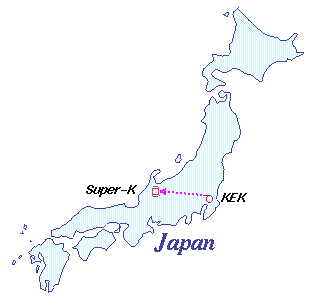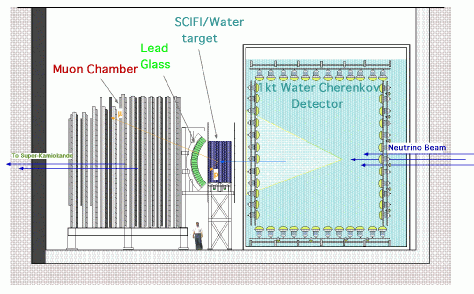
After the Super-Kamiokande experiment announced evidence for neutrino mass using data obtained with atmospheric neutrinos it became more vital then ever to confirm this important result.

The evidence for neutrino flavor oscillation and massive neutrinos in the Super-Kamiokande experiment rely on neutrinos produced high in the upper atmosphere of the earth when cosmic rays collide with air molecules. Because the exact energy spectrum and flux of these cosmic rays is not knows the exact number and energy of the neutrinos that are produced is also uncertain.
In order to confirm the neutrino oscillation hypothesis a new
experiment known as K2K(KEK to Super-K) is now taking place.
Instead of relying on neutrinos from collisions in the upper
atmosphere we are producing neutrinos in an accelerator at the
Japanese National Accelerator Facility KEK and shooting them down into
the earth 250Km across Japan where they are detected by the
Super-Kamiokande detector.
The K2K experiment is the first long-baseline neutrino oscillation experiment which will use an artificially produced and controlled neutrino beam. Neutrinos produced at KEK are also detected and measured at a near detector 300 meters downstream from the target so that the properties of the beam such as intensity and energy spectrum can be measured and understood.

While traveling through the Earth the neutrinos achieve a depth
of 1 kilometer at the halfway point of their journey and by the
time they reach the Super-Kamiokande detector the width of the
beam is almost 1 kilometer across. The beam is centered on the
Super-Kamiokande detector but it only interacts with the center
part of the beam. Because of this it is very important that in
addition to measuring the intensity and energy spectrum of the
neutrinos we produce we also measure the profile of the beam.

The near detector used to measure the properties of the neutrino beam is made up of two main parts. The "1 kilo-ton water detector" is a small scaled down replica of the much larger 50 kilo-ton Super-Kamiokande detector. By making this detector as similar as possible to the large detector 250 kilometers away we can compare the properties of the neutrinos measured both close to and far away from the neutrino source using the same techniques.
There is also a fine grained detector made out of scintillating
fibers, lead glass, and large steel plates to accurately measure
the energy of muons that are produced, and where precision
measurements can be made of the beam profile and also physics
cross-sections that can help us interpret the results at the
Super-Kamiokande detector.
The neutrino beam used in the K2K experiment is produced by a 12 GeV proton beam taken from the KEK Proton Synchrotron with fast extraction. After hitting an aluminum target the positively charged particles produced by the beam are focused by a pair of magnetic horns. These charged particles(mostly pions) then enter a long tunnel where they decay and produce neutrinos. The beam is estimated to be 99% muon neutrino with a 1% electron neutrino contamination. The peak energy of the resulting neutrinos is estimated to be 1 GeV and the mean energy 1.4 GeV. The beam's momentum and divergence is monitored by a pion monitor downstream of the second horn. Information about the beam's profile is also obtained from a muon monitor installed downstream of the decay tunnel. After 3 years of operation we expect a total of 1 x 10^20 protons to hit our target.